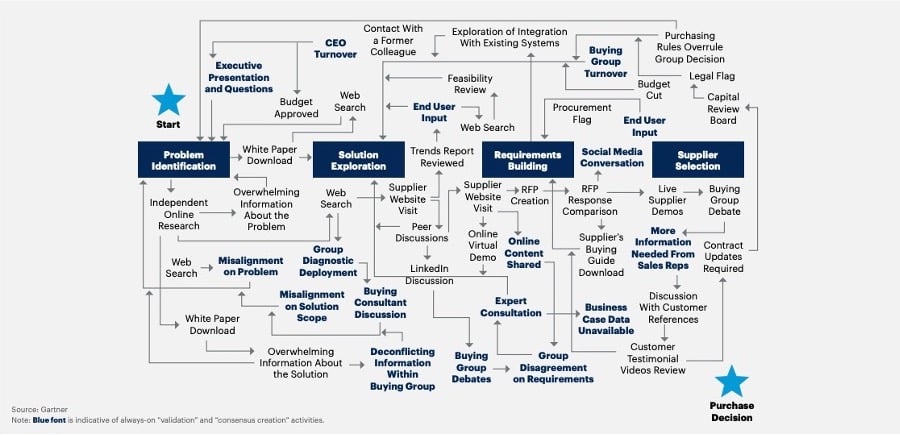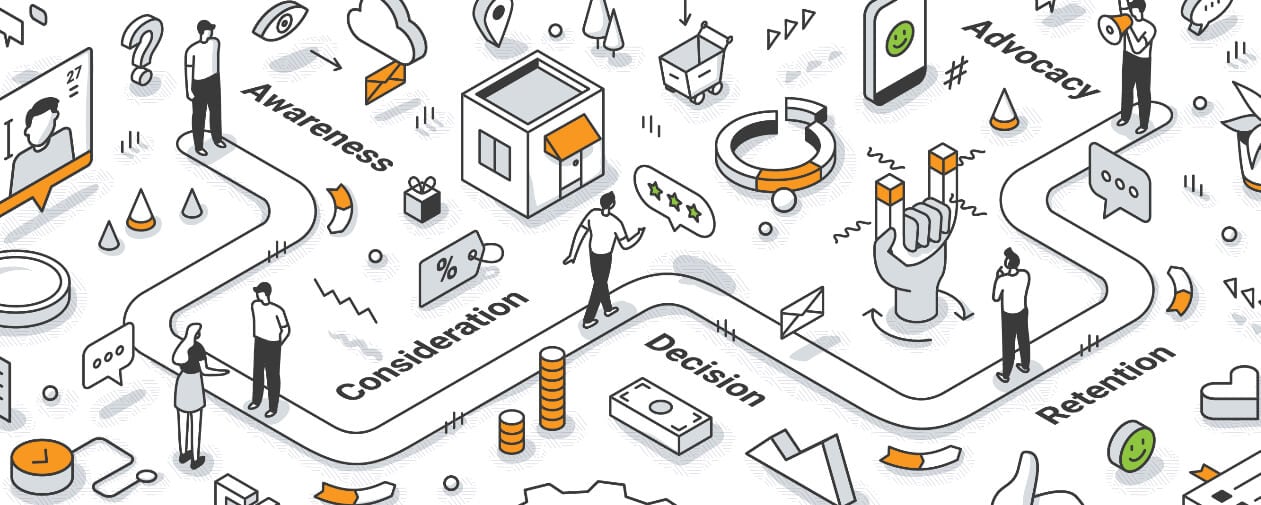Customer journey maps allow you to codify, track, and adapt to those nuanced interactions, those between-the-lines moments that can make or break your customer relationship. They can also help you pinpoint opportunities to over-deliver on the customer experience.
Keeping close tabs on your customers is inherent to effective customer success. But if you want true customer intimacy—that deep level of understanding that enables great customer experiences – you must glean and analyze how your customers interact with you and your product. Enter customer journey maps.
An enabler of the four pillars of customer success, journey maps serve as a blueprint of the specific steps (touchpoints and interactions) your customers take when they engage with you so you can ensure their success with your brand and product (pre- and post-purchase).
No matter how your customers interact with you (social media, email, live chat, or other channels), a customer journey map helps tell the story of your customers’ experience with and expectations of you at every engagement stage. They also reveal how a customer moves toward specific goals and help you identify sticking points at each customer journey touchpoint. Understanding where your customers are at any given time is crucial to optimizing their experience and to preventing any retention opportunities from slipping through the cracks.
Here’s how to pinpoint your customers’ milestones, goals, and steps—from their perspective—so you can ensure a successful journey with your product and keep them glued to you.
Map the Customer Journey for Customer Success
Customer success teams have the noble task of empowering customers to have success with your product and the power to intervene in delicate situations that can make or break the customer experience. The unique value customer journey maps offer customer success teams is that they illuminate customers’ actual experiences with you and your product, providing an intimate understanding of their customers’ needs, wants, and pain points. They should be a staple in your customer success tool chest.
That said, the most effective customer journey maps are created cross-functionally and involve all stakeholders, at least that’s what we do here at MarketSource. Customer success should include sales, marketing, product, and other teams to provide a comprehensive, 360° view and ensure accountability for all customers at every stage of their lifecycle with you.
A customer success journey map looks at an entire typical customer journey through a customer’s lens, with the goal of surfacing deep insights and opportunities to intentionally inject high points into the customer experience.
As part of your broader customer success strategy, journey maps can have a big impact. Read on for how to create a customer journey map that you can apply to your entire customer base to:
- Assess the current and plan the future state of your customer journey
- Gain intimate customer insights
- Optimize the customer experience
- Reduce churn
5 Key Questions for Your Customer Journey Map
Ready to begin your Customer Journey Map? Ask these 5 questions:
 |
What do you want to measure? | Decide what problem(s) you want your map to surface. |
 |
What’s it like to be your customer? | Whiteboard what it’s like to be in your ecosystem—from purchasing to terminating and everything in between. Involve all stakeholders. |
 |
What typical stages do your buyers go through? | How do your customers get to you, and what happens to them at each stage? |
 |
How do your customers define success with your product? | You may have goals for your customers with your product, but you need to understand what success with your product looks like to them. |
 |
What patterns do you see? | Look for patterns in triggering events and customer responses, and identify gaps in customer experiences. |
Journey maps are customized for your business, and which fields you include will depend upon your goals (to pinpoint reasons customers leave following certain triggering activities, for example) and the nature of your business and your customers.
There are templates available, but a simple spreadsheet or visualization tool (like Miro) can work well and give you the flexibility to easily shift parameters according to your goals and what you want to measure at a given point in time. You’ll end up with a dashboard that allows you to cross-reference across categories.
Your map should include:
- Stages of the buying process
- Target customer personas
- User actions (contact product support, renew their subscription) and touchpoints (website, social channels, live chat, etc.)
- Emotional milestones
- Obstacles and pain points
To get started on building your map, in collaboration with stakeholders from every function, including marketing, L&D, sales, revenue, etc., ask these five questions:
What do you want to measure?
Decide what problem(s) you want your map to surface. Are you looking for ways to improve your clients’ experience through the selling process? Your new customer onboarding process? Your answer will determine the parameters to include in your map. Prioritize the most critical interactions and trigger points for your customers and your business.
What’s it like to be your customer?
With your departmental stakeholders in one room, whiteboard what it’s like to be in your —from purchasing to terminating and everything in between. Map how customers find you, make purchasing decisions, onboard, install your product, secure product support, report issues, receive responses from customer support, recommend your product to others, and more. Be sure not to omit any interactions, touchpoints, or channels.
NOTE: As Gartner research finds, the journey is typically complex and will not be linear:

What typical stages do your buyers go through?
Map the steps your customers take as they move from problem identification, solution exploration, requirements building, supplier selection, validation, to consensus creation. You’ll then cross-reference each stage with personas, channels, and emotional milestones.
How do your customers define success with your product?
You may have goals for your customers with your product, but you need to understand what success with your product looks like to them. Customer journey maps depict the value and outcomes your customers expect from your product and/or services. While that will differ by customer, you’ll see patterns emerge. Gather this information through surveys or Net Promoter Scores. Chart the typical emotional milestones and obstacles or pain points customers experience and at which stages.
What patterns do you see?
You’ll see patterns in customer behavior and sentiment start to emerge. Identify what triggers customers to move to the next stage in the journey and the gaps that prevent them from doing so. Put an action plan together for each issue.
How to Put Your Journey Map to Work
After mapping, you’ll be able to see where all your customers are in the customer success lifecycle and assess their level of engagement and product satisfaction. Once you have enough data, you can then decide how to escort them to the next phase of their journey.
You’ll also discover how to operationalize the ways you can support them better and optimize their experience with you. Key to that is implementing a feedback loop that allows you to capture and communicate changes you’re making as soon as you uncover problems so your entire team can get on board and adapt immediately.
You can replicate and/or refresh your map as your customer journey goals change.
Ready to talk?
Looking for ways to optimize your customer experience? We can help.

Author: Karen Salamone
Karen is Head of Marketing for MarketSource. She is a transformational B2B and B2B2C leader with a history of building marketing organizations, content teams, and demand generation centers of excellence from the ground up. She is recognized for delivering meaningful insights and fresh approaches and for earning best-in-class content, design, and multi-media awards.
Want More Sales?
Subscribe now to receive occasional emails with insights that help you accelerate profitable growth, risk reduction, market expansion, and revenue velocity.
What are you waiting for?

